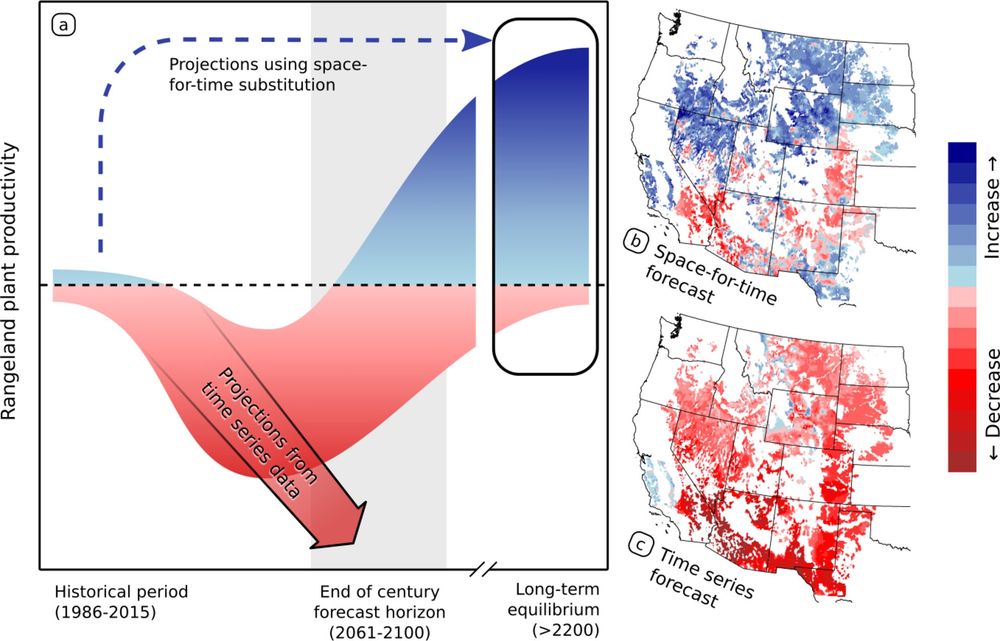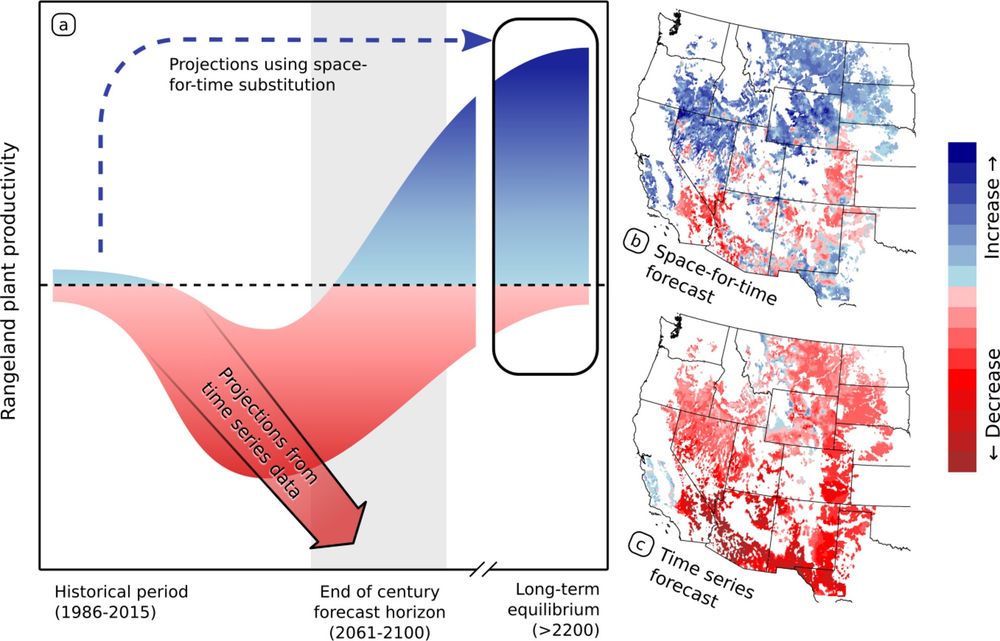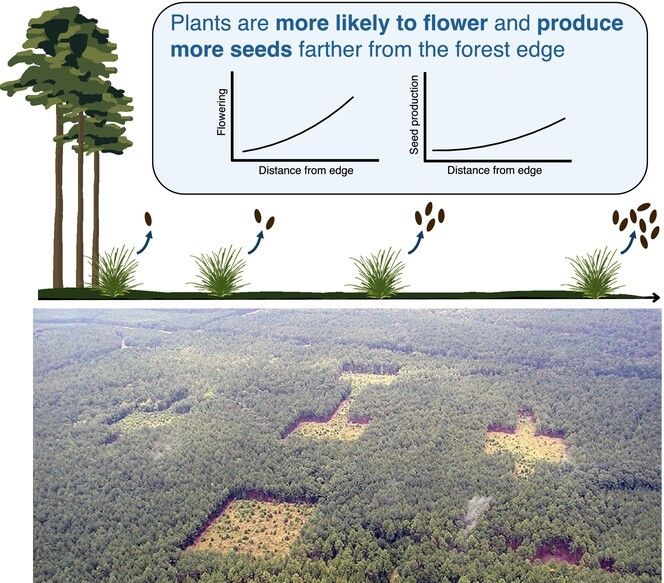Michael (Misha) Stemkovski
@mishastemkovski.bsky.social
Climate change, pollination, community ecology. Postdoc at Utah State University. https://www.stemkovski.com/
Reposted by Michael (Misha) Stemkovski
New paper out on the dangers of using patterns across spatial climate gradients to predict what will happen with changing climate. That includes species distribution modeling. Space-for-time substitution can be misleading in sign, not just the magnitude of effects.
www.nature.com/articles/s41...
www.nature.com/articles/s41...

Reconsidering space-for-time substitution in climate change ecology - Nature Climate Change
Ecologists often leverage patterns observed across spatial climate gradients to predict the impacts of climate change (space-for-time substitution). We highlight evidence that this can be misleading n...
www.nature.com
July 31, 2025 at 4:04 AM
New paper out on the dangers of using patterns across spatial climate gradients to predict what will happen with changing climate. That includes species distribution modeling. Space-for-time substitution can be misleading in sign, not just the magnitude of effects.
www.nature.com/articles/s41...
www.nature.com/articles/s41...
Space-for-time substitution is most problematic when forecasting near-term ecological responses that lag behind climate change. It assumes equilibrium (rapid ecological responses) and strong climate causality (ignoring confounders). www.nature.com/articles/s41... @mekevans.bsky.social

Reconsidering space-for-time substitution in climate change ecology - Nature Climate Change
Ecologists often leverage patterns observed across spatial climate gradients to predict the impacts of climate change (space-for-time substitution). We highlight evidence that this can be misleading n...
www.nature.com
July 30, 2025 at 7:18 PM
Space-for-time substitution is most problematic when forecasting near-term ecological responses that lag behind climate change. It assumes equilibrium (rapid ecological responses) and strong climate causality (ignoring confounders). www.nature.com/articles/s41... @mekevans.bsky.social
Reposted by Michael (Misha) Stemkovski
A synthetic paper about fast vs. slow responses of ecological systems to changing climate, explaining how and why those responses can shift (even in sign) over time. Examples across scales and subdiscplines (population genetics, ecosystem ecology). besjournals.onlinelibrary.wiley.com/doi/10.1111/...

Ecological acclimation: A framework to integrate fast and slow responses to climate change
Read the free Plain Language Summary for this article on the Journal blog.
besjournals.onlinelibrary.wiley.com
June 25, 2025 at 5:31 PM
A synthetic paper about fast vs. slow responses of ecological systems to changing climate, explaining how and why those responses can shift (even in sign) over time. Examples across scales and subdiscplines (population genetics, ecosystem ecology). besjournals.onlinelibrary.wiley.com/doi/10.1111/...
I’m very excited to share a paper from an incredible team of evolutionary biologists, community ecologists, paleoecologists, social scientists, and biogeochemists. “Ecological acclimation” unites processes that take minutes to centuries: besjournals.onlinelibrary.wiley.com/doi/10.1111/...

Ecological acclimation: A framework to integrate fast and slow responses to climate change
Read the free Plain Language Summary for this article on the Journal blog.
besjournals.onlinelibrary.wiley.com
June 26, 2025 at 8:05 PM
I’m very excited to share a paper from an incredible team of evolutionary biologists, community ecologists, paleoecologists, social scientists, and biogeochemists. “Ecological acclimation” unites processes that take minutes to centuries: besjournals.onlinelibrary.wiley.com/doi/10.1111/...
Reposted by Michael (Misha) Stemkovski
New paper led by @mishastemkovski.bsky.social Ecological acclimation: A framework to integrate fast and slow responses to climate change besjournals.onlinelibrary.wiley.com/doi/10.1111/...

Ecological acclimation: A framework to integrate fast and slow responses to climate change
Read the free Plain Language Summary for this article on the Journal blog.
besjournals.onlinelibrary.wiley.com
June 24, 2025 at 1:49 PM
New paper led by @mishastemkovski.bsky.social Ecological acclimation: A framework to integrate fast and slow responses to climate change besjournals.onlinelibrary.wiley.com/doi/10.1111/...
Reposted by Michael (Misha) Stemkovski
New paper with Erica Henry & @nickhaddad.bsky.social
Q: What happens when butterflies, responding to climate warming, attempt an extra generation as summers get longer?
A: Long-term monitoring shows overwinter population growth increases! 🧪🦋🐛https://onlinelibrary.wiley.com/doi/10.1111/ele.70018
Q: What happens when butterflies, responding to climate warming, attempt an extra generation as summers get longer?
A: Long-term monitoring shows overwinter population growth increases! 🧪🦋🐛https://onlinelibrary.wiley.com/doi/10.1111/ele.70018

Voltinism Shifts in Response to Climate Warming Generally Benefit Populations of Multivoltine Butterflies
Insects may respond to climate warming by advancing phenology and increasing the number of generations each year (voltinism). However, one concern is that earlier phenology changes cue-response relat...
onlinelibrary.wiley.com
April 2, 2025 at 4:34 PM
New paper with Erica Henry & @nickhaddad.bsky.social
Q: What happens when butterflies, responding to climate warming, attempt an extra generation as summers get longer?
A: Long-term monitoring shows overwinter population growth increases! 🧪🦋🐛https://onlinelibrary.wiley.com/doi/10.1111/ele.70018
Q: What happens when butterflies, responding to climate warming, attempt an extra generation as summers get longer?
A: Long-term monitoring shows overwinter population growth increases! 🧪🦋🐛https://onlinelibrary.wiley.com/doi/10.1111/ele.70018
Reposted by Michael (Misha) Stemkovski
New paper led by superstar grad student Katherine Hulting, from the SRS Fragmentation Experiment
Across 5 species & 1000s of plants, habitat edges decrease plant reproductive output by suppressing flowering, but not by changing pollination rates
besjournals.onlinelibrary.wiley.com/doi/10.1111/...
Across 5 species & 1000s of plants, habitat edges decrease plant reproductive output by suppressing flowering, but not by changing pollination rates
besjournals.onlinelibrary.wiley.com/doi/10.1111/...

Habitat edges decrease plant reproductive output in fragmented landscapes
The authors demonstrate that plant reproductive output (seed production) is decreased by habitat fragmentation through edge effects on flowering. This work provides evidence that an important contrib....
besjournals.onlinelibrary.wiley.com
November 29, 2024 at 2:49 PM
New paper led by superstar grad student Katherine Hulting, from the SRS Fragmentation Experiment
Across 5 species & 1000s of plants, habitat edges decrease plant reproductive output by suppressing flowering, but not by changing pollination rates
besjournals.onlinelibrary.wiley.com/doi/10.1111/...
Across 5 species & 1000s of plants, habitat edges decrease plant reproductive output by suppressing flowering, but not by changing pollination rates
besjournals.onlinelibrary.wiley.com/doi/10.1111/...

